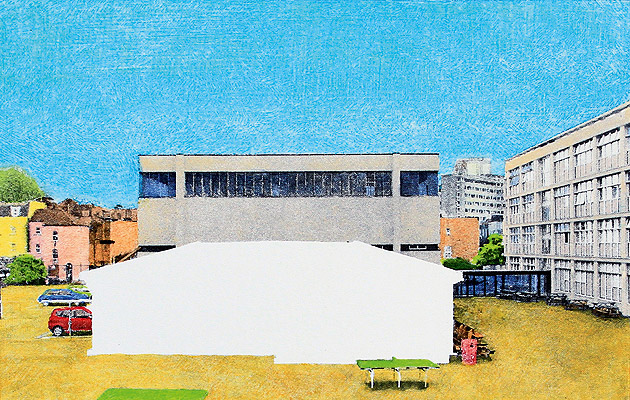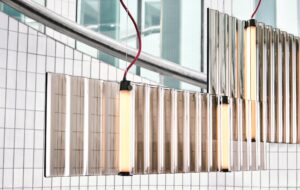|
Halcyon Days (Haggerston School Redux 1), 2013 (image: Charlie Warde) |
||
|
Charlie Warde’s exhibition in Ernö Goldfinger’s home both celebrates and also challenges the architect’s vision, says Hazel Tsoi-Wiles What do fashion designers wear? What do nutritionists eat? Where do architects live? In Ernö Goldfinger’s case, that would be 2 Willow Road, a 1930s modernist home in Hampstead that he designed and built for himself and his family. The man behind Trellick Tower, Balfron Tower and Metro Central Heights applied the same bold, uncompromising, functional and innovative features of his housing projects to his own home. Walls fold back to create large entertaining spaces, drawers and cupboards are built into walls and the central spiral staircase runs through the three storeys like a slender thread, taking up minimal space in a home that maximises the potential of every inch. The National Trust takes care of this modernist dream house and proudly refers to it as a “personality home”. Everything is exactly as Goldfinger left it. Without velvet ropes or overbearing stewards, it’s hard to resist plucking his books off the unprotected bookshelves or turning on the taps in the bathroom. But in case you get too relaxed in the surroundings and forget yourself, small laminated cards are left on the toilet seats, declaring “Historic toilet. Please don’t use me!” Artist Charlie Warde has been granted more privileges than the average visitor. His exhibition This Must Be The Place, part of his artist’s residency at 2 Willow Road, comprises three artworks in the nursery and a fourth in the garage. Goldfinger encouraged his children to draw on the nursery walls and be creative in their space – while staying firmly separate from his carefully designed adult spaces below. Even now, under the National Trust’s care, all things by Ernö are segregated from all things about Ernö. In a glass case sits Memories for the Future, Warde’s postcard-sized etchings of Balfron Tower, Trellick Tower and Metro Central Heights. On this scale, they are like mementoes of pilgrimages to architectural places of worship. The plates are copper, the buildings are plated in 24-carat gold and, after processing, the copper is tarnished while Goldfinger’s buildings remain flawless and bright. Warde playfully invokes the man’s Midas-like name, and is unhesitant in applying precious metal, skilled labour and tender craftsmanship to praising Goldfinger’s work. Warde invites different perspectives on Goldfinger in An Ideal Home. Trellick Tower residents submitted drawings of their ideal home on postcards. These were entered into a competition and six are displayed at 2 Willow Road. Some show Trellick Tower, by residents who either misunderstood the brief or believe they currently live in their ideal home. Others show double-fronted detached houses with chimneys and front gardens. Another is simply a VW Camper. In their own words (drawings in this case), the residents poignantly emphasise the reality of living in someone else’s vision: they live in Goldfinger’s ideal home, not theirs. Prometheus lurks in the garage in the form of Warde’s stop frame animated film of that name. It’s simply 228 prints of Trellick Tower flickering across the screen, the white outline of the iconic building blurring, fading then emerging out of a blue background, like a flip book of blueprints. Warde submerged etched zinc plates in an acid bath between prints, forcefully deteroriating the image. The resulting film is hypnotic, accompanied by a soundtrack featuring Trellick Tower field recordings by sound artist James Torrance. It is a psychogeographic experiment, all ghostly traces and haunting visions of a place that is real and mythical at the same time. Warde assigns Prometheus’ civilising gift of fire to mankind to Goldfinger – and to himself. Each of the 217 households in Trellick Tower received a print and a message from Warde explaining the project and Goldfinger’s importance. He emulates his hero, dispensing original prints to residents who may not appreciate them. Intentionally, or unintentionally, he highlights the tension between giver and receiver of gifts – as shown in An Ideal Home, the two do not always agree on what is ideal. As a title, This Must Be The Place is optimistic, anxious and uncertain. There should be a question mark, but this lies in the ambivalent and poignant works themselves. Warde simultaneously celebrates and challenges Goldfinger’s attempts at building Utopia, using his own gold-plated admiration to insist that these must be the places where Utopia exists, and residents’ less glowing understanding of Trellick Tower to challenge whether it is actually there. This Must Be The Place, 2 Willow Road, Hampstead, London, Until 3 November 2014 |
Words Hazel Tsoi-Wiles |
|
|
||


















